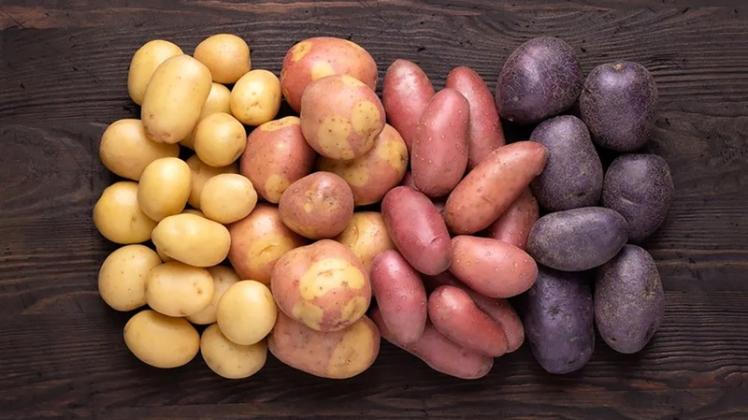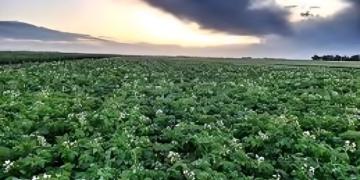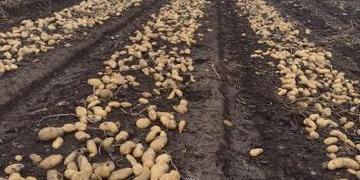Argentina: Mendoza potatoes face major challenges in a campaign with rock-bottom prices.
The Habemus Papas event highlighted the potential of the crop in the province and opened the debate on the future of the production chain.

The event served to enhance the exchange of knowledge acquired by experts dedicated to researching the potato. One of the first speakers to share his knowledge on the panels scheduled for the meeting was Federico Fulligna, a leading expert on the subject from the National Institute of Agricultural Technology (INTA) - La Consulta. In providing an overview of potato production nationwide, Fulligna explained that there are 85,000 hectares under cultivation in the country, most of which is concentrated in the southeast of Buenos Aires; an area where potato cultivation predominates and which accounts for between 50 and 55% of the total cultivated hectares.
On the Argentine map, the area cultivated with potatoes occupies the central region (mainly Córdoba and San Luis) with 30%; Tucumán with 9%; and, depending on the year, between 6% and 7% in Mendoza. The truth is that, of this total production, the researcher explained, between 50% and 55% of the harvested varieties are used for direct consumption; 30%-35% is used for various industrial purposes; and between 5% and 6% is returned to the soil to be planted as "seed."
In Mendoza, data indicate that the largest potato crop area is concentrated in the Uco Valley, Tupungato, and San Carlos, where approximately 65 to 70% of the area cultivated is planted with potatoes. While the former department primarily cultivates varieties intended for regular household consumption, the latter is dominated by potatoes intended for industrial use and Simplot potatoes. Towards the south of the province, seed potato cultivation is also widespread, with an estimated 10 to 15% coverage. The remainder of Mendoza’s potato production is concentrated in the eastern and northern regions.
Thus, in the three links that comprise the potato production chain, there are potatoes used as seeds for new crops, potatoes sold to the final consumer, and potatoes destined for processing. Among the notable varieties, the so-called "Spunta" is the most prominent, due to its characteristics: it is more stable and easier to cultivate compared to the other varieties. Meanwhile, the high-quality "Sagitta" has begun to spread to be used in processing.
In this sense, the growth of the dehydrated potato industry in Mendoza has positioned the province in a privileged position on the national map. Potato quality is defined by each use and depends on the shape of the tubers, their size, the absence of diseases and defects, and their flavor and texture. Other factors that determine their quality include aspects such as visual appeal, consumer culinary preferences, and the ability to meet market demands.
Low consumer prices and low profitability
Omar Carrasco, president of the Mendoza Fruit and Vegetable Association, emphasized that potato production this season has reached expected levels in terms of volume. However, he stressed that, compared to previous years, potatoes "have been at cost price for some time now; therefore, investments are not covered by sales." Carrasco pointed out that a bag of potatoes is currently sold well below cost.
“Sales are very low, there’s no cash; there’s no money, and sales have slowed down dramatically. So prices are flat. As a result, many products, such as potatoes, are in short supply,” Carrasco warned, referring to the national situation. He explained that, with low sales prices, producers are faced with the difficulty of not being able to cover their costs. “The same thing is happening with onions, carrots, lettuce, and tomatoes,” the association’s president explained.
From the perspective of local potato producers, the reality shows the same complexity: "The potato sector, at the production level in Argentina, is experiencing a year of high production and low prices that are not profitable for producers," said a Mendoza potato producer and marketer, adding that "next year may see a more promising year."
Malargüe, birthplace of the seed potato
Guillermo Aguado is a seed potato producer based in the department of Malargüe. Drawing on the experience he has gained over the years and the dedication he has put into achieving his production, he emphasized that one of the most complex challenges facing this sector of Mendoza’s agricultural sector relates to the crop’s susceptibility to viruses that are transmitted as the tuber reproduces through the sprouts themselves. The result is that this situation—the transfer of these agents during the reproduction process—carries a risk of a decrease in the total volume of potatoes produced.
Their commitment to achieving premium potato quality in Mendoza is closely linked to their history: it was in the 1940s and 1950s when seed potatoes were imported from Holland in the province. Due to the complications that arose during that period, marked by a high dependence on the foreign country, a group of producers joined together to take the first steps toward establishing local seed potato production. Guillermo Aguado’s uncle and father were part of this group of entrepreneurs. The underlying goal that united these generations was, in fact, to harvest a virus-free potato from the land.
To achieve this, the producer commented, he complemented his experience by creating a laboratory that serves as a greenhouse and is used to obtain small plants, which are then planted and harvested to produce new, healthy tubers that are later marketed to producers. This process, Aguado explained, takes between four and five years. Explaining the care required to achieve high-quality results, the producer explained that this process must be carried out in relatively isolated areas, so that new crops do not run the risk of being infected by pathogens from nearby plantations. Mosquitoes, aphids, and viruses are among the most common threats to potato crops.
The importance of ensuring the traceability of seed potatoes is no small feat, and in fact, there are examples abroad of cases in which producers are unable to obtain this "mother" crop without some level of biological contamination. Therefore, thanks to the initiatives undertaken by Malargüe producers, Argentina has been positioned as one of the countries with the highest renewal rate. "Producers generally buy seed potatoes every year because they understand that their production is increasingly better," Aguado emphasized, pointing out that producers generally need to stock up, and that there are even cases in which the plantation is done once, the seed is grown, and then the production is resumed for consumption. In this way, he clarified, a multiplier effect can be applied. Córdoba and Buenos Aires are provinces that use seed potatoes produced in Malargüe; what is sought in these cases is the vigor and guarantee of health that the local product represents.
The challenges facing the potato production sector include more than just the threat of disease. While the season promises high production levels in these lands, crop prices are actually declining, and therefore, seed potato sales prices are falling. Regarding this year’s profitability, Aguado emphasized, "producers are losing more than half of their investment. A hectare of potatoes costs eight thousand dollars. Planting them and getting them ready for harvesting is key," Aguado emphasized, comparing the sales price to the range of four to five thousand dollars per hectare.
Referring to the macroeconomic situation, the Malargüino producer emphasized that the ideal scenario for potato production at the national level would be to be able to export more than 50% of production, thereby bringing in dollars, although this possibility is limited due to high costs. While in cases where seed potatoes are unavailable in European countries, the situation can represent an opportunity for local producers, the reality is that economic conditions are complex. Therefore, a first step toward achieving better prospects, Aguado clarified, is the possibility of a stable dollar. "Stabilizing the dollar is an achievement. And then we have to compete with quality and price abroad," Aguado assessed.
Juan Gómez Saá is a seed potato producer at the La Alejandra ranch (La Carrera, Tupungato). He emphasized the need to strengthen the work of producers and vendors, as the current stage requires the sector to define the variety it wants to develop. This aspect, he clarified, depends on "adaptability to the soil, to lack of water or excess water, and to hail."
Once that step is completed, the next step is to certify the seed to provide the buyer with certainty regarding its quality, ensuring that it is virus-free.
Andean potato, the variety that grows at the foot of the mountain range
Eduardo Barraud’s experience stands out when referring to Andean potato production in Mendoza. In his case, he has been producing the vegetable in the Uspallata region for eight years. His journey of perfecting his ability to harvest high-quality potatoes, previously uncultivated in the province, began after a trip to Peru. It was on that adventure that the Mendoza native realized that potatoes have colors, diversity, and flavors that are not limited to specific varieties. After receiving appropriate technical advice from professionals at INTA (National Institute of Agricultural Technology), Barraud embarked on the task of laying the first furrows with varieties imported from Peru.
It was during those months that experience began to gather reliable information based on the crop’s adaptability to the Mendoza climate. Thus, at least 40 varieties have already been explored by this producer, 14 of which were chosen to continue production in the Uspallata area.
One of the biggest challenges, in his case, was selling his produce. "We’re developing in that area. We started with Sueño Verde, in Buenos Aires, and Ríe la Huerta, here in Mendoza," the local producer commented, clarifying that, in the latter case, the produce is sold among the home-delivered agroecological products.
Regarding this year’s production, Barraud estimated a harvest of 110,000 kilos, a high volume compared to eight years ago, when the total harvest reached 700 kilograms. "We grew in volume, reproducing the potatoes to have more seeds. And we discarded those seeds that had low production, focusing on those with greater volume, potential, and color. We prefer those with antioxidants, which are the ones that attract the most attention, and the ones that are most different from traditional potatoes as well," the producer explained, adding that there is a niche in the gastronomic sector that, through his Andean potato production venture, has been able to provide a quality response. In fact, distribution takes place in at least 20 restaurants, where the vegetable is distributed directly. "I think there is still a lot to do; it is the link we need to explore," expressed the producer, one of the pioneers in the production of this potato variety in Mendoza.
Fuente:




